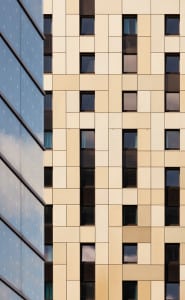Aluminium panels have been used in construction for nearly 50 years, originally invented by Alcan and Alusuisse in 1964. The original design remains broadly the same to this day, consisting of two aluminium sheets that are bonded to an insulated core.
Various brands of aluminium panel emerged such as Alucobond and whilst aluminium panel brands continue to exist, the construction industry generally refers and specifies “aluminium sandwich panels” or “aluminium insulated panels”.
Since their original conception, aluminium panels have retained their primary use
Whilst many of us in construction will mainly use aluminium panels for external cladding of buildings in other sectors they have many other uses.
- internal cladding of buildings such as column casings and coverings
- signage as a lighter cheaper alternative – shop signs or construction signs
- container construction providing a strong and higher alternative to traditional steel containers
- providing panelled insulation in general use wherever an insulated “wall” is required
- machine coverings to provide sound resistance if required
- false ceilings and partitions as a modern alternative to other materials
More recently aluminium panels have been used as backing materials for mounting art and photography where artists have found an alternative and contrasting backing to their artwork.
The main advantage in construction of aluminium panels remains low weight, high strength and design flexibility. The insulated core typical of aluminium panels can give aluminium panels several other advantages in construction such as varying degrees of insulation or fire resistance.
Coatings and finishes remain a major advantage of aluminium panels.
With a variety of coatings available to aluminium panels such as PVDF (polyvinyl fluoride) or polyester powder finish, aluminium panels can be painted in virtually any colour. The aluminium sheets can be coated different colours on each side depending upon whether they are visible from inside the buildings.
Other technologies such as sublimation can also create aluminium panels that have a wood, marbled or artistic effect.

